- Home
- Bill Bryson
The Road to Little Dribbling Page 34
The Road to Little Dribbling Read online
Page 34
Allport appointed a young engineer named Charles Sharland to get the line built. Almost nothing is known about Sharland other than that he came from Tasmania and was only in his early twenties. The immensity of the task confronting him was almost unimaginable and made all the harder by the privations of labouring in a wilderness. Sharland slept in a waggon and often worked for hours in drenching rains or driving snow. Even more remarkably, he did all this while suffering acutely from tuberculosis. Inevitably, it caught up with him and, with his work almost finished, he retired to Torquay at the age of just twenty-five. He died soon afterwards, never having seen a train run on the line he helped to create. I had hoped to see his residence when I was in Torquay, but he was too obscure, it seems, for anyone to have noted where it was. But I could at least have a look at his line now.
It opened on 1 May 1876, and from its beginning it was a magnificent folly. For practical reasons it didn’t even go terribly near many of the communities it was built to serve. Kirkby Stephen station is a mile and a half from the village of Kirkby Stephen. Dent station is four miles from, and a steep six hundred feet above, Dent village.
I have ridden the line several times and the views across this very austere end of the Dales are sensational, but you can’t really appreciate the engineering from the train. For that, you must stand alongside it. I stopped at Dent Head viaduct now and got out to have a look. The viaduct is 199 yards long with ten arches, and rises a hundred feet above the valley floor. That doesn’t sound spectacularly lofty when you just say it, but when you see it in three dimensions it is stunning. I had to tilt my head back so far that I lost my balance and almost fell over.
British Rail spent years trying to close the line, and did succeed in running it down almost to nothing. Dent station was closed for sixteen years and many of the others received only minimal attention. Today, however, the line is a model of what you can do with a little intelligent management and marketing. Now seven trains a day run in each direction, and the number of passengers has gone from ninety thousand in 1983 to a staggering 1.2 million in 2013.
The most iconic structure on the Settle-to-Carlisle line is Ribblehead Viaduct, running a quarter of a mile across the rolling valley of the River Ribble. It has twenty-four arches and at its highest point stands 106 feet above the surrounding landscape. For years British Rail wanted to close it, on grounds of cost, and build a modern steel bridge to run alongside. This of course would have ruined one of the classic sights of Yorkshire. Fortunately sense prevailed, money was found and the viaduct was restored. That is the crux of matters, of course. If you have a lot of good old stuff and you want to keep it, you have to pay for it. If you don’t pay for it, you can’t keep it. I believe I have just described modern Britain.
I drove on through lovely countryside on quiet lanes. Gradually the road climbed to higher ground and the landscape grew bleaker and rockier, but was still very beautiful. It is the contrast between the green valleys, with their herds of dairy cattle prettily dotting grassy fields, and the lonely, whispering uplands that stand above that makes this landscape so perpetually enchanting.
At Garsdale Head, a lonely pass miles from anywhere, I passed the famous Moorcock Inn (or Nymphomaniac’s Plea, as I always think it), then descended to the busy, tourist-clogged village of Hawes, where I became the first person in history to drive through without stopping to look in shop windows for an hour. Why people choose to go there when everywhere else in the world is not there is a mystery beyond answering. I drove on instead to Swaledale and Wensleydale, two of the loveliest of the dales. I stopped at Thwaite and walked to the nearby village of Muker and back, on a path through fields of dairy cows, which mercifully failed to molest me. Then I drove to Askrigg, which once teemed with tourists and tour buses because it was the village of Darrowby in All Creatures Great and Small, but it seems pretty quiet now, which must make it a nicer place to live if not to sell souvenirs, cups of tea and planks of wood with inspirational sentiments on them.
About five miles beyond Askrigg is Aysgarth Falls, a celebrated beauty spot. It isn’t exactly Niagara, but rather a series of small falls, where the waters of the River Ure flow over several limestone platforms, but what it lacks in drama it makes up for in comeliness, and there is always the pleasure of watching some idiot falling in the water while trying to cross the river on exposed rocks. Some noisy young oik splashed in while I was there, to the delight of everyone present.
At length I arrived in Leyburn, a busy market town, full of cars. I stopped at a restaurant on the square called Penley’s, where I had a spicy cajun wrap, and wondered what odds William Hill would have given thirty years ago that one day people in Yorkshire country towns would be eating spicy cajun wraps.
Leyburn is not the most attractive of places, but it is the starting point for a wonderful, secret walk. Behind the shops at the western edge of the marketplace is a wooded bluff called Leyburn Shawl, which runs for nearly two miles high above Wensleydale and provides the most magnificent views. According to legend, it got its name when Mary, Queen of Scots, dropped her shawl there while trying to escape from nearby Bolton Castle, where she was held prisoner for six months in 1568. The problem with this story is that shawl isn’t first recorded in English until 1662, long after Mary had a neck to wrap anything around. The Oxford English Dictionary doesn’t have an entry for shawl as a landscape feature, which is a curious oversight, but there you are. Life sometimes bitterly disappoints.
Beyond the Shawl – considerably beyond, as it turns out – is the village of Preston-under-Scar and then the striking, solitary upright known as Bolton Castle, which stands like a giant forgotten chess piece on a hillside. For reasons considerably beyond my knowledge, the castle is called Bolton Castle while the village beside it is Castle Bolton. Bolton Castle dates from the late fourteenth century and is impressive in an austere sort of way. Admission to view the castle was £8.50, which was more than I was willing to pay by a multiple of about four. Besides, I was running very late. It was much further from Leyburn than I had remembered. It had taken me nearly two hours to get there, which meant that I wouldn’t get back to my car till after 5 pm, and I still had about an hour’s drive after that. This little side trip, glorious as it was, was costing me my happy hour. So with a certain scoot in my stride, I bade farewell to Bolton Castle Bolton and strode briskly back towards Leyburn and my trusty hire car.
I spent the night in Barnard Castle, a pleasant market town on the River Tees in County Durham. I arrived much too late to go to the famous Bowes Museum there, a disappointment. So instead I had a walk around the town as darkness fell, and found it entirely agreeable. C. Northcote Parkinson, I was interested to see, was born at No. 45 Galgate, a fact commemorated with a plaque on the house. Never has anyone milked a single thought more vigorously and successfully than he did. The line for which he is remembered was ‘Work expands to fill the time available for its completion,’ still known as Parkinson’s Law. It was first elucidated in a comic essay he wrote for The Economist in 1955 while he was a professor at the University of Malaya in Singapore. Parkinson then expanded the essay into a thin book, called Parkinson’s Law, which became a global bestseller and made him rich and more famous than anyone deserves to be for having one fairly obvious idea. He was given visiting professorships at Harvard and the University of California at Berkeley, and undertook many long, lucrative speaking tours. He wrote several other books, including some novels, though nothing he wrote enjoyed anything like the success of Parkinson’s Law. Nonetheless he made so much money that he became a tax exile in Guernsey. He died in 1993, aged eighty-three, having done nothing of interest for thirty-five years. Even so, he gets about 1,500 words in the Oxford Dictionary of National Biography, while poor old Charles Sharland, forgotten father of the Settle-to-Carlisle railway, gets none. Go figure.
Barnard Castle has many pubs, most of them pretty promising looking. I called in at the Old Well Inn for a pre-dinner beverage and found it most congenial, I
must say. Beside my table was a recent issue of a trade magazine called Pub and Bar, which I picked up and read with interest and then admiration, for it was not only engaging but literate – and how often can one say that these days? I was particularly taken with an article about a pub called the White Post on Rimpton Hill on the Dorset–Somerset border. The county boundary runs right through the middle of the bar. In former times when Dorset and Somerset had different licensing laws, people had to move from one side of the room to the other at 10 pm in order to continue drinking legally until 10.30. I don’t know why but this made me feel a pang of nostalgia for the way things used to be.
Afterwards, I went to an Indian restaurant and had a curry and spent the next ten hours having pangs of quite another sort. I won’t say I was delirious, but I had some strange dreams. I woke up at one point with what I genuinely thought was a brilliant and original observation and wrote it down on a notepad on the bedside stand, then forgot about it.
In the morning, I rediscovered it as I packed up. It said: ‘On the plus side, Jimmy Savile will be dead for ever.’
If there was a minus side to the thought, I’m afraid I failed to note it.
Chapter 25
Durham and the Northeast
I
JUST OUTSIDE Gloucester Road tube station in London is an open area that used to have a large planter in the middle of it. The planter contained some hardy shrubs and was enclosed by a low wall on which people could sit to eat a sandwich or wait for friends. It wasn’t sensational but it was pleasant.
Then one day the council took the planter away, turning the open area into a kind of arid plaza. Soon afterwards when I passed through, a couple of council officials in bright yellow vests were standing in the newly created emptiness making notes on a clipboard. I asked them why they had taken away the planter, and they told me that the borough didn’t have the resources to manage planters any more. And I just thought: is that really what we have come to now, in this cheap, shittily dispiriting age in which we permanently reside – that we can’t even afford a few shrubs in a planter?
Now hold that thought just for a minute while we speed north to the fine old city of Durham and stand outside the majestic heap of stone that is Durham Cathedral. I once spent an enjoyable morning being shown around by the cathedral’s architect, Christopher Downs. I was a little surprised, frankly, to discover that a cathedral, even a grand and ancient one, requires a full-time architect, but it does. It is in the nature of old buildings to want to fall down, and they need constant attention to prevent that happening. Stone, for one thing, isn’t nearly as eternal as you might think. Even hard stone tends to split and crumble after a couple of hundred years of facing into wind and rain. When that happens, Christopher told me, masons carefully chip out the old stone and slide in a new one. This puzzled me. Why, I asked, didn’t they just pull out the existing stone and rotate it to a new face?
He looked at me, surprised at my architectural naivety. ‘Because the stones are only about six to nine inches thick,’ he explained. It turns out that the walls of Durham Cathedral are not solid stone, as I had always vaguely supposed, but consist rather of an outer skin six to nine inches thick and an inner skin of similar thickness and in between a cavity five and a half feet across, which the builders filled with rubble and hardcore held together with a kind of gloopy cement-like mortar.
So Durham Cathedral, like all great buildings of antiquity, is essentially just a giant pile of rubble held in place by two thin layers of dressed stone. But – and here is the truly remarkable thing – because that gloopy mortar was contained between two impermeable outer layers, air couldn’t get to it, so it took a very long time – forty years to be precise – to dry out. As it dried, the whole structure gently settled, which meant that the cathedral masons had to build door jambs, lintels and other horizontal features at slightly acute angles so that they would ease over time into the correct alignments. And that’s exactly what happened. After forty years of slow-motion sagging, the building settled into a position of impeccable horizontality, which it has maintained ever since. To me, that is just amazing – the idea that people would have the foresight and dedication to ensure a perfection that they themselves might never live to see.
Now I am no expert on the matter, but I am pretty sure that we are a lot richer today than we were in the eleventh century, and yet back then they could find the resources to build something as splendid and eternal as Durham Cathedral and today we can’t afford to keep six shrubs in a planter. And there is really something seriously wrong with that, if you ask me.
I’m biased, but I believe Durham may be the nicest small city on the planet. It is friendly, brainy, carefully preserved, very beautiful. I said some complimentary things about Durham in Notes from a Small Island and the university gave me an honorary degree. When I came to accept the degree, I said some more complimentary things and they made me chancellor. This is my kind of town.
Being a university chancellor is a position that almost nobody outside the world of British academia understands. When my hero and friend Sir Kenneth Calman, who was then vice-chancellor at Durham, invited me to take on the role in 2005, my first question to him was: ‘What does a chancellor do?’
‘Ah,’ he said in a tone of genial wisdom, ‘a chancellor is rather like a bidet. Everyone is pleased to have one, but no one knows quite what they are for.’
A chancellor is nominally the head of a university, but in practice has no role, no power, no defined purpose. A university is really run by the vice-chancellor. ‘Your job,’ Ken told me, ‘is to be harmless and amiable, and to preside over graduation ceremonies twice a year.’ And so for six years that is what I did, and I loved it. It was, I discovered, a little like being Queen Mother and Father Christmas at the same time.
The British do a lot of things remarkably well and often seem hardly aware of it, and nowhere is that more true than in the provision of higher education. Compare the situation of British universities with that of American ones. As everyone knows, the amount of money American universities have at their disposal is staggering. Harvard University’s endowment is $32 billion – that’s more than the gross domestic products of most nations. Yale has an endowment of $20 billion, Princeton and Stanford are both at $18 billion, and so on through a very long list.
In Iowa, my own state, Grinnell, an eminently respectable liberal arts college but one that not many people outside the Midwest have ever heard of, has 1,680 students and an endowment of $1.5 billion – or more than all British universities put together apart from Oxford and Cambridge. Altogether eighty-one universities in America have endowments of $1 billion or more.
That’s just endowments. It doesn’t touch on the huge sums they take in from tuition and sports programmes and a good deal else. Do you know, Ohio State University earns $115 million a year from its sports programmes, of which some $40 million – I am actually embarrassed to say this – comes in the form of donations. That’s right. People give $40 million a year to the Ohio State University football team just so it can attract better players – and, for all I know, better cheerleaders. Forty million dollars is about equal to the total endowment of Exeter University in the UK. Only twenty-six British universities have total endowments greater than the amount given annually to the Ohio State University football team.
I first became interested in all this when I sat at a dinner next to a fundraiser from the University of Virginia, who mentioned, as if it were the most natural thing in the world, that they had just embarked on a five-year campaign to raise $3 billion. To achieve this, the university employed a dedicated fundraising staff of two hundred and fifty people. The head of the department was paid $500,000 a year – more than anybody at the university except the football coach. The University of Virginia, in short, had turned itself into a mighty cash-raising machine.
It met its target, a remarkable accomplishment, but here’s the thing. According to the 2014 Times Higher Education world rankings (which a
re generally held to be the most exacting of their type), the University of Virginia ranks 130th among the world’s universities. Eighteen much more modestly funded British universities rank higher. On the world stage, according to the Times Higher, Virginia is about level with Britain’s Lancaster University, which has an endowment fund one-thousandth the size of Virginia’s. That is pretty extraordinary.
And it is all the more extraordinary when you reflect that despite perpetually modest funding Britain still has three of the world’s top ten universities and 11 of the top 100. Put another way, Britain has 1 per cent of the world’s population, but 11 per cent of its best universities, and accounts for nearly 12 per cent of total academic citations and 16 per cent of the most highly cited studies.
I very much doubt if there is any other realm of human endeavour in the country that produces more world-class benefit with less financial input than higher education. It is possibly the single most outstanding thing in Britain today.
One of the weirdest experiences I have ever had occurred on an ancient and noble span called Elvet Bridge in Durham, which I had forgotten all about but remembered now as I strolled across it on my way to the cathedral. Elvet Bridge dates from the twelfth century and because of its great age and narrowness is closed to motorized traffic. I used it a lot when I was in Durham for Congregations, as graduation weeks are known, because it stood between my hotel and the cathedral, where the graduation ceremonies took place in an atmosphere of stirring pomp and splendour.
One morning, as I was hurrying to the cathedral for the first ceremony, I felt a strange urge to look over the side of the bridge. I have no idea why. Directly beneath me, thirty or forty feet below, two young mums with pushchairs were chatting on a path beside the swift and rain-swollen River Wear. One of them had a toddler. Just as I looked down, the toddler, unnoticed, stepped on to a boat ramp beside them. It was a bigger step down than he could quite manage and he unbalanced and tumbled into the water. He sank completely, then bobbed up on his back, still slightly submerged, with an exceedingly startled look on his face. I was directly in his line of sight. We made eye contact, connected by this unexpected moment. The little boy was in an eddy sheltered by the ramp, and for a moment he lay becalmed, but then he began very gently to spin, and to move towards the open river, as if being tugged by a current.

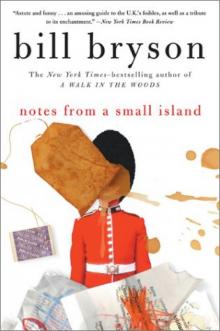 Notes from a Small Island
Notes from a Small Island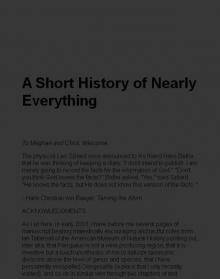 A Short History of Nearly Everything
A Short History of Nearly Everything A Walk in the Woods
A Walk in the Woods I'm a Stranger Here Myself
I'm a Stranger Here Myself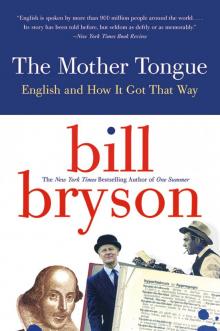 The Mother Tongue
The Mother Tongue Shakespeare
Shakespeare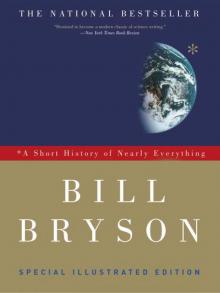 A Short History of Nearly Everything: Special Illustrated Edition
A Short History of Nearly Everything: Special Illustrated Edition The Best American Travel Writing 2016
The Best American Travel Writing 2016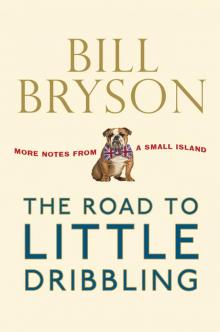 The Road to Little Dribbling
The Road to Little Dribbling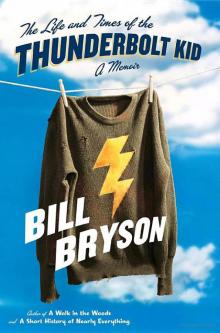 The Life And Times Of The Thunderbolt Kid: A Memoir (v5.0)
The Life And Times Of The Thunderbolt Kid: A Memoir (v5.0) Made In America
Made In America Seeing Further
Seeing Further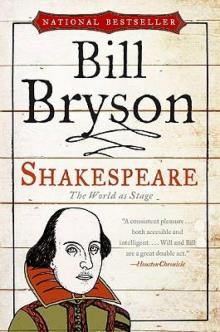 Shakespeare: The World as Stage
Shakespeare: The World as Stage The Life and Times of the Thunderbolt Kid
The Life and Times of the Thunderbolt Kid At Home
At Home Bryson's Dictionary For Writers And Editors (v5.0)
Bryson's Dictionary For Writers And Editors (v5.0) Neither Here Nor There
Neither Here Nor There Bill Bryson's African Diary
Bill Bryson's African Diary